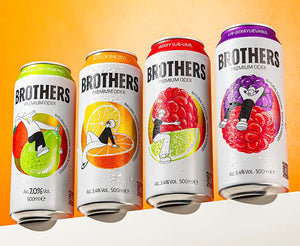Cider is a very popular traditional drink made from fermented apple juice. But there are many interesting facts about the drink that most cider-fans may not know. For example, cider alcohol content varies from 1.2% to 8.5% ABV which can be higher or lower than the alcohol content of beer.
Cider can be classified from sweet to dry, and the flavour of cider can vary depending on the variety of apples used and the length of fermentation. The colour of cider can also vary from rich, warm golden tones to cloudy or pale straw.
No matter how you like your cider, let’s take a look at five more facts about English cider that will make you say, "Oh, I didn't know that!"
1: The Popularity Of Cider
Britons most widely consume cider, but it is also popular in Commonwealth countries, such as Australia, New Zealand and Canada. It is a favourite drink in European countries like Ireland, Spain, France, Portugal and Italy.
2: The Long History Of Cider Making
Cider-making can trace its roots back as far as 55BC when the Romans noticed locals drinking a fermented drink made from apples. The Romans then took cider-making back to Italy, where it quickly spread in popularity throughout the Roman Empire.
The practice of wassailing is an old English custom still carried out today in some areas of the southwest of England and is supposed to appease the deities of the apple trees and ensure a good crop of cider apples.
3: Cider The Safety Drink!
Drinking cider was considered safer than drinking water in the years between the 13th and 17th centuries. It wasn't uncommon for labourers to be paid in cider, and there are even stories of babies being baptised in cider because it was cleaner and more bug-free than the drinking water at that time.
Cider was even advertised as a health tonic and a cure for gout and other minor malaise during the 19th Century.
4: Cider Apple Varieties
While you can make cider from any type of apple, particular varieties grown in the UK are specifically used for cider-making. These apple strains are high in acids and tannins, and the varieties used by Brothers Cider to make their tasty range can include Dabinett, Yarlington Mill, Harry Masters, Somerset Redstreak and Browns Apple.

Many cider experts believe there are around 360 distinct cider apple varieties in England, but many of these are so rare that there are only a few individual trees left in some orchards.
5: Cider Apple Fermentation
Cider apples are fermented in the same way as wine. The first fermentation can be carried out by naturally occurring yeasts present on the apples' skins or the cider-makers choice of yeast may be added. During fermentation, the natural sugars found in the apples are converted to ethanol.
Another form of fermentation is called the malolactic fermentation stage which occurs during the maturation stage. During this period some of the naturally occurring malic acid is converted to lactic acid, this softens and mellows the cider. The cider maker can add sugar or extra fruit juice and create a secondary fermentation, which will increase the ethanol content in the finished cider and is known as conditioned cider. This can be done in cask or bottle to produce a naturally sparkling product.
Cider can be ready to drink after three months of maturation, but many cider makers will mature cider in vats for up to three years to allow a full and unique character to develop.


